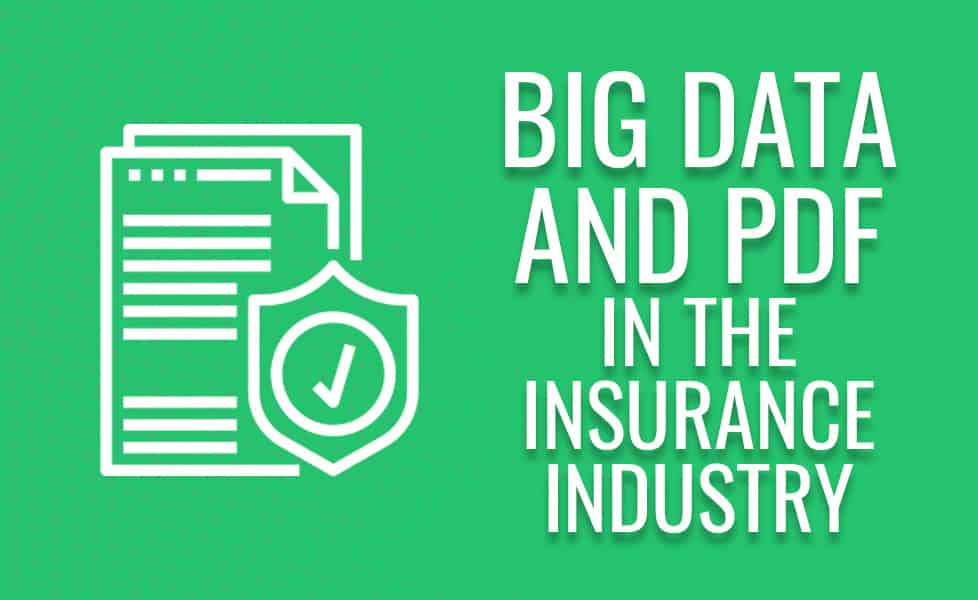Big Data and PDF in the Insurance Industry

Big data plays an important role in decisions that companies make. This applies to a wide range of industries and sectors. And insurance companies are no different. They can increase profits by using the data potential customers provide to them to better provide insurance cover.
Identifying trends
Big data enables insurance providers to identify trends among age groups or geographical locations. These trends include when people are more inclined to upgrade or look for more comprehensive cover. In the long run, big data can help you better profile your company’s risk.
It’s interesting to note that in 2014, when big data was on everyone’s lips, 47% of insurance providers were not recruiting data scientists to do this type of analysis, according to a Bearing Point survey. Yet 71% of respondents to the same survey said that exploiting big data was a high priority. But where do you find it?
Big data for insurance companies
The first step is to analyze how you collect customer data. In the case of the insurance industry, the most common places to extract customer information are as follows:
- Sign up forms
- Claim forms
- Renewal forms
The common thread here is form. Insurance industry operators use a multitude of forms to collect information. These forms, collectively speaking, are ripe for analysis and can have a major impact on company procedures. As per the example above with age groups or geographical locations, looking into the time of year when people upgrade their insurance based on their location is just one instance of the type of analysis you could perform.
So where does PDF come in?
The insurance industry is extremely regulated. It’s no surprise that this has inhibited many insurance companies from becoming paperless. However, more and more companies are moving to a paper-free approach due to:
- Cost-cutting benefits
- Faster accessibility
- Convenience for customers
- Environmental regulations
PDF trends in the insurance industry
Paper forms are becoming a thing of the past. You expect your customers to print out and fill in a form and then mail it to you. This means more time and money spent in an ever-busier world. With a PDF editor, your customers could view, fill out and email you the form instantly, without needing to print it.
But let’s go one step further, what if your customers could view and fill in your PDF form in a browser. This form is then submitted to your database at the click of a button. This form could create a profile for a new customer, update an existing customer’s profile or alert the relevant department that a claim has been made. This is what’s possible with a Web based PDF SDK.
Insurance companies usually have large document management systems. As well as facilitating the client data entry process, high-quality PDF technology allows you to organize access to your database and retrieve the information you need faster. Our full-text search functionality allows you to perform a search with keywords directly in a database. This capability enables you to find a contract or key document in seconds.
Exporting Form Data through FDF
FDF stands for Forms Data Fields and is commonly used for saving annotations and form data. Once information is input into a form and submitted in a browser, you can save it as an FDF file. This file type saves only the form field data, and not the whole form file.
Depending on how you create your online form, there are numerous ways to save and use the information in it. After creating the FDF file, you can parse the information using a CGI script. You can then populate fields in a database with this information. Of course, this requires some database knowledge so that the imported information directly links to the fields in your database. Alternatively, you can save a submitted form as a PDF file and send it to an email address. In this example, a new customer form is then sent to the finance department for invoicing and sign off.
To Summarise
PDF forms are a lot more than a static piece of digital paper. By plugging your database into PDF technology you can automate your workflows. This frees up more time for your employees to spend on more important tasks.
If you are in the insurance industry and looking to develop an application that can revolutionize the way that your company does things, we would love to hear from you. We are experts in this field and can bring your document management to the next level. Get in touch below for a free trial.

